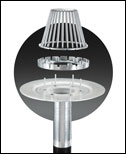As a Professional Roofing reader, you know NRCA has been at odds with the Occupational Safety and Health Administration (OSHA) for the past two years concerning the agency's revised fall-protection rules for residential roofing. Those rules, published in December 2010, effectively mandate the use of what OSHA calls "personal fall-arrest systems"—harnesses and lanyards—except in limited circumstances.
NRCA has argued, from the beginning, that limiting safety options doesn't make sense from a safety point of view, nevermind from a regulatory point of view. And, we have argued, the use of personal fall-arrest systems creates its own hazards—most notably tripping—that are likely to create the potential for even more accidents and injuries.
The Bureau of Labor Statistics recently issued its Census of Fatal Occupational Injuries for 2011. It is troubling and instructive to note the number of fatal falls involving residential roofing increased from the prior year. It's troubling because nearly all falls can be prevented with the right equipment and training. It's instructive because it indicates OSHA should be working with the industry to expand the use of effective fall-protection options, not limit them.
A separate report about OSHA enforcement activities from 2006-10 shows during that time period there was a 15.3 percent increase in violations, 22.1 percent increase in serious violations and 217.1 percent increase in willful violations. Most citations involving fatal falls are serious, willful or both.
During our most recent meeting with OSHA officials, we learned 90 percent of the agency's citations that stemmed from roofing falls were issued when there was no fall protection at all in place. We argued—and continue to contend—that's where 100 percent of the agency's efforts should be focused. Instead, we hear reports of citations when, for example, an inspector sees the last worker off a roof unhook his or her lanyard before going down the ladder.
This matter really shouldn't be so difficult or controversial. Falls can be prevented. There are many ways to prevent them, depending on the job, type of materials being used and each roof's specific attributes. Personal fall-arrest systems certainly can be an effective fall-protection solution, but so can other solutions. We know training helps a lot. And the insurance industry is increasingly vigilant about fall protection. But requiring a cumbersome one-size-fits-all fall-protection solution only reduces options for responsible employers and invites unprofessional employers to cheat, which is easily done by simply doing nothing.
The facts would seem to support our position. It's too bad facts and rules don't often seem to align.
Bill Good is NRCA's executive vice president.



